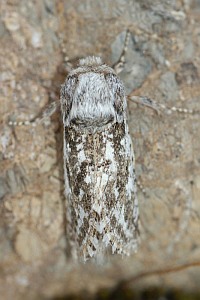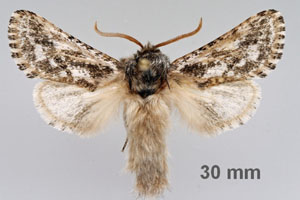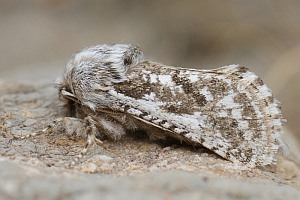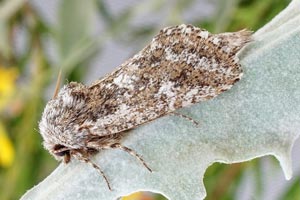

 +1Kontinente:EU
+1Kontinente:EU1. Lebendfotos
1.1. Falter
2. Diagnose
2.1. Geschlecht nicht bestimmt
3. Biologie
3.1. Lebensweise
Besiedelt werden die trockensten Lebensräume Spaniens - wovon sich die Raupen dort ernähren, scheint unbekannt zu sein. Nach de Freina & Witt (1990) sind die Falter in der Morgendämmerung aktiv (Anfang Mai bis Mitte Juni).
3.2. Nahrung der Raupe
Noch unbekannt!
4. Weitere Informationen
4.1. Andere Kombinationen
- Dyspessa foeda almeriana de Freina & Witt, 1990 [Originalkombination und bis Yakovlev (2008) übliche Kombination]
4.2. Taxonomie
Yakovlev (2008) nimmt gleich zwei Veränderungen vor: er wertet die bisherige ssp. almeriana aus Südostspanien in den Rang einer Art auf und er kombiniert diese neu mit Eremocossus. Aus Dyspessa foeda almeriana wird dadurch Eremocossus almeriana.
Die Gattung Eremocossus ist nur schlecht definiert - Yakovlev (2008) schreibt dazu: "The genus Eremocossus Hampson, 1892 was proposed for Phragmataecia faeda Swinhoe, 1884, when it was described from southern Pakistan. This is perhaps the most taxonomically complicated genus of the Carpenter moths because of its scarcity in collections and unclear synonymy due to the loss of Turati’s types from Libya. For this reason, a detailed revision of the genus is impossible until topotypic specimens are obtained to design neotypes. Hence, in this work the taxa within the species (or species group) E. vaulogeri (Staudinger, 1897) are given as a short catalogue with provisional synonymy which cannot be taken as being definitive."
Auch die Aufwertung der spanischen Unterart zur Art wird nur sehr knapp erläutert: "the species differs much from other species of the genus by the fore wing features (broader and shorter, with a specific pattern of alternating light and grey elements) and peculiarities of the ♂ genitalia (reduced lateral processes on the aedeagus at the distal end)."
Nach der Abtrennung der ssp. almeriana als eigene Art tritt die eigentliche, aus Pakistan beschriebene Eremocossus foeda (= Dyspessa foeda) nicht mehr in Europa auf. Als Dyspessa foeda bezeichnete Tiere aus Nordafrika gehören zu Eremocossus vaulogeri (Staudinger, 1897).
4.3. Faunistik
Das Vorkommen der Art beschränkt sich auf die südspanischen Provinzen Alicante und Almeria (de Freina & Witt 1990a).
4.4. Literatur
- de Freina, J. J. & T. J. Witt (1990a): Die Bombyces et Sphinges der Westpalaearktis (Insecta, Lepidoptera). Eine umfassende, reich illustrierte und revidierte Gesamtdarstellung der Bombyces und Sphinges Europas und Nordwestafrikas in mehreren Bänden. Band 2. - 140 S.; München (Edition Forschung & Wissenschaft Verlag).
- Erstbeschreibung: de Freina, J. J. & T. J. Witt (1990b): Zur Systematik des paneremisch verbreiteten Dyspessa foeda-vaulogeri-Komplexes mit Beschreibung einer neuen Unterart aus Südostspanien (Lepidoptera, Cossidae). — Nachrichtenblatt der bayerischen Entomologen, 39 (1): 20-25. [PDF auf zobodat.at]
- Swinhoe, C. (1885): On Lepidoptera collected at Kurrachee. — Proceedings of the scientific meetings of the Zoological Society of London for the Year 1884 (4): 503-529, pl. XLVII-XLVIII.
- Yakovlev, R.V. (2008): Notes about the Genus Eremocossus Hampson, 1892 (Lepidoptera: Cossidae). — Atalanta 39 (1-4): 404-411. Würzburg. [PDF auf zobodat.at].






